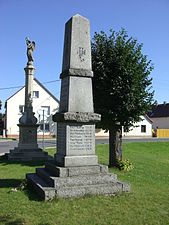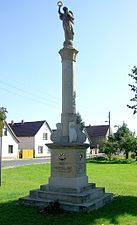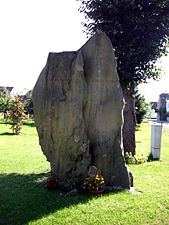Stolzenhain village church
The Protestant village church Stolzenhain is a Grade II listed church building in the district Stolzenhain the community Röderland in southern Brandenburg Elbe-Elster . Here the church is surrounded by the local cemetery in a central location in the center of the village.
history
The Stolzenhain church was built in 1592. It was subordinate to the parish in Saathain , founded in 1575 , where at that time a castle chapel was located near the Saathain manor house, but which was replaced by a half-timbered church in 1629 . In the course of time the church in Stolzenhain became the mother church of the parish, which is why the clergy of the parish, if they also died here, were buried in the churchyard in Stolzenhain. Another daughter church of the Parish was located in Prosen , which also belonged to the Saathain domain and was also responsible for pastoral care in the village of Reppis near Gröditz . In 1602, a plague cemetery was set up near Stolzenhain because plague victims from the neighboring village of Schweinfurth, which was also part of Saathain, were not allowed to be buried in the cemetery at the Stolzenhain church in the center of the village. In 1768 the first schoolhouse in Stolzenhain was built across from the churchyard.
After the Wars of Liberation , as a result of the Congress of Vienna in 1815, Saxony was divided and large parts of its territory had to be ceded. The new border ran in the region along the road from Mühlberg to Ortrand . The communities on the road fell to Prussia . With this, Stolzenhain and other parts of the Grossenhain Office were incorporated into the Kingdom of Prussia and have since belonged to the Prussian Province of Saxony . With Schweinfurth, Reppis and Gröditz, however, some parts of the former Saathain dominion remained with Saxony. The towns of Reppis and Schweinfurth in Saxony were finally parished out in 1904 and 1905, Schweinfurth to Nauwalde and Reppis to Frauenhain. There have been suggestions for this since 1840, but it was not until 1905 that the division of the parish "laboriously and reluctantly" came about through a state treaty . The Schradengemeinde Wainsdorf, in turn, was parish into the Saathain-Stolzenhain parish that year. It previously belonged to the Frauenhain , which was still in Saxony . After a diakonia had already been set up there a few years earlier, Prosen, which had grown considerably in number , became an independent parish from 1910 together with Wainsdorf.
In 1928 the tower of the Stolzenhain church had to be demolished. This was badly submerged in severe flooding in the summer of 1926 as a result of a dam breach by the Großer Röder near Würdenhain . The design of the new tower is based on the previous building in its current form. In the 1930s, the Stolzenhain church was placed under monument protection because of its pulpit and the existing ceiling paintings . Further restoration work was carried out under Pastor Wolfgang Bastian from 1936 to 1937. Among other things, the roof of the church and sacristy were renewed and the southern half-timbered vestibule was rebuilt based on the previous building. Furthermore, the church received a new coat of paint and the tower received a new weather vane sponsored by the local blacksmith.
In 1965 the sacristy was added or rebuilt instead of the half-timbered building that originally existed here. The entire structure was restored between 1986 and 1992. In 2008 the roof was renewed with a beaver tail double covering. In addition, the church received a new lightning protection system .
architecture
The Stolzenhain church is a single-nave, plastered hall with a gable roof, sleek arched windows and a retracted rectangular choir, built in 1592 . The square church tower from 1928 that adjoins it to the west has an octagonal upper part with a tail hood and lantern . There are lower extensions to the side of the tower. A half-timbered vestibule built in 1936 and a sacristy built in 1965 adjoin to the south .
Furnishing
The interior of the Stolzenhain church is characterized by a horseshoe gallery and a richly painted wooden beam ceiling. The painting dates from the time the church was built, around 1600. It is illustrated with representations of the Old Testament books Genesis , Exodus and Numbers . The paintings on the parapet of the gallery depict events from the Annunciation to Pentecost . There is a stucco framed ceiling in the choir .
The wooden altarpiece also dates from around 1600. Like the predella, it is richly painted and fitted with fittings , diamond blocks and masks. The wooden pulpit is also dated to around 1600. In the pulpit there are paintings of Salvator mundi and the evangelists.
Other pieces of equipment include an altar crucifix from the 18th century and the carved figure of a standing Madonna from the 15th century .
The church received its first organ in 1792, for which purpose the gallery was expanded. The instrument, which was bought second-hand in Plessa in good condition , was expanded to include a pedal the following year . The costs for this are said to have been almost as high as for the organ itself. In 1893 the organ was replaced by an instrument from the Schweidnitz organ building company Schlag & Söhne (op. 376). Organs from this company were previously installed in the vicinity as early as 1890 in Plessa (op. 322, preserved), in 1892 in the Martinskirche in Val Gardena (not preserved) and in Saathain (not preserved).
The Stolzenhainer organ has a pneumatic box drawer , a manual and 6 stops with a pedal .
|
|
||||||||||||||||||
Tombs
Inside the church there is the painted wooden epitaph of Peregrina Vogel, who died in 1616, and tombstones from 1689 and 1730 in the tower entrance and in the southern vestibule .
South of the church on the village green is a war memorial for the fallen villagers of the Franco-Prussian War (1870/71) from 1879. It shows the Greek goddess of victory Nike standing on a stepped base .
In the immediate vicinity there is a memorial for the fallen of the First World War in the form of a three-part stele and a sandstone rock slab as a memorial for the victims of the Second World War .
Literature (selection)
- Hermann Kötzschke: The origin of the parish Stolzenhain-Saathain . In: The Black Magpie . No. 394 , 1930.
- Hans Appel: The replacement of services and payments in kind in Stolzenhain . In: The Black Magpie . No. 477 , 1934.
- Wolfgang Bastian : On this year's renewal of the church in Stolzenhain . In: The Black Magpie . No. 525 , 1936.
- Hans Appel: From Stolzenhain's past . In: The Black Magpie . No. 549 , 1938.
- Georg Dehio: Handbook of the German art monuments - Brandenburg . 2nd Edition. 2012, ISBN 978-3-422-03123-4 , pp. 1079-1080 .
Web links
- Entry in the monument database of the State of Brandenburg
- Homepage of the Protestant Church in Prösen
Notes and individual references
- ^ Database of the Brandenburg State Office for the Preservation of Monuments and the State Archaeological Museum ( Memento from December 9, 2017 in the Internet Archive ), accessed on September 25, 2016.
- ↑ a b c d e f Wolfgang Bastian : On this year's renewal of the church in Stolzenhain . In: The Black Magpie . No. 525 , 1936.
- ↑ a b c d e f Hermann Kötzschke: The origin of the parish Stolzenhain-Saathain . In: The Black Magpie . No. 394 , 1930.
- ↑ Publication: Peace treatise between Ihro Königl. Majesty of Saxony etc. and Ihro Königl. Majesty of Prussia etc. completed and signed at Vienna the 18th, and ratified on May 21st, 1815, Dresden [1815]. In the state archive of Saxony-Anhalt .
- ^ Walter Döhring, Gerhard Schmidt: Einsiedel, Detlev von. In: New German Biography (NDB). Volume 4, Duncker & Humblot, Berlin 1959, ISBN 3-428-00185-0 , p. 400 f. ( Digitized version ).
- ↑ Reppis in the Historical Directory of Saxony , accessed on October 15, 2016.
- ↑ Schweinfurth in the Historical Directory of Saxony , accessed on October 15, 2016.
- ^ A b Luise Grundmann, Dietrich Hanspach (author): Der Schraden. A regional study in the Elsterwerda, Lauchhammer, Hirschfeld and Ortrand area . Ed .: Institute for Regional Geography Leipzig and the Saxon Academy of Sciences in Leipzig. Böhlau Verlag, Cologne / Weimar / Vienna 2005, ISBN 3-412-10900-2 , p. 170 .
- ^ Klaus Ramm: Church and local history from Prösen and the surrounding area . Ed .: Evangelische Kirchengemeinde Prösen. 2008, p. 33 .
- ^ Rudolf Matthies : History of the village Würdenhain . 1953 (compiled within the framework of the national construction work with subsequent additions by Ursula, Heinz and Matthias Lohse).
- ↑ a b c d e f g h i j Georg Dehio: Handbook of the German Art Monuments - Brandenburg . 2nd Edition. 2012, ISBN 978-3-422-03123-4 , pp. 1079-1080 .
- ^ "Vocal Ensemble in Stolzenhain" in Lausitzer Rundschau , December 16, 2011.
- ↑ Beavertail replaces double roman. In: Lausitzer Rundschau , October 24, 2008.
- ↑ a b c d e cultural office of the Elbe-Elster district, Bad Liebenwerda district museum, Sparkasse Elbe-Elster (ed.): Elbe-Elster organ landscape . Herzberg / Elster 2005, p. 54 .
- ↑ Cultural Office of the Elbe-Elster district, Bad Liebenwerda district museum, Sparkasse Elbe-Elster (ed.): Orgellandschaft Elbe-Elster . Herzberg / Elster 2005, p. 62 .
- ↑ The Val Gardena Church on the homepage of the Schradenland Office , accessed on September 30, 2016
- ↑ a b Online project Memorial Monuments , accessed on October 16, 2016
Coordinates: 51 ° 26 '22.6 " N , 13 ° 27' 0.8" E





